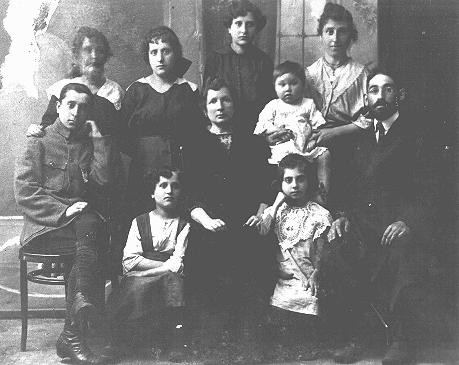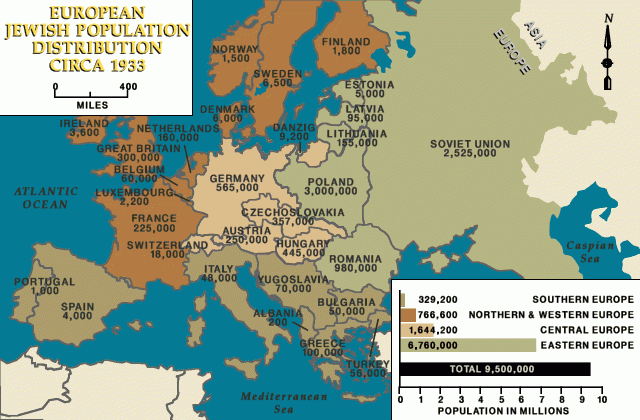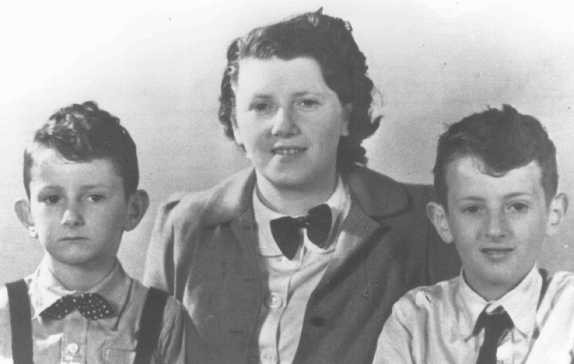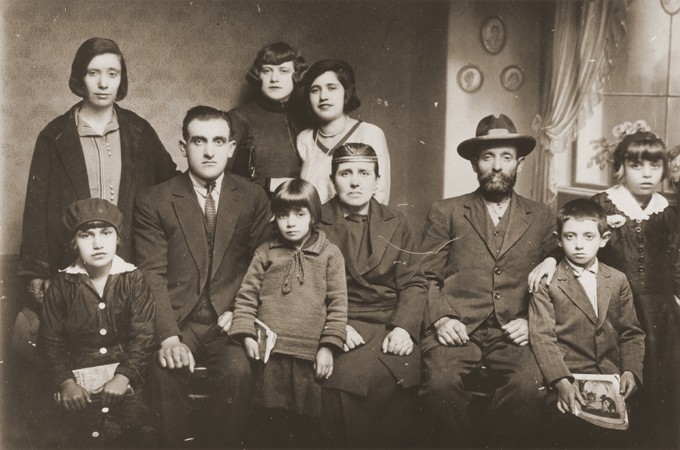
Jewish Population of Europe in 1933: Population Data by Country
Before the Nazis seized power in 1933, Europe had a richly diverse set of Jewish cultures. Many of these cultures were dynamic and highly developed. They drew from hundreds and, in some areas, a thousand or more years of Jewish life on the continent.

In 1933, approximately 9.5 million Jews lived in Europe, comprising 1.7% of the total European population. This number represented more than 60 percent of the world's Jewish population at that time, estimated at 15.3 million.
Eastern Europe
The majority of Jews in prewar Europe resided in eastern Europe. The largest Jewish communities in this area were in Poland, with about 3,000,000 Jews (9.5%); the European part of the Soviet Union, with 2,525,000 (3.4%); and Romania, with 756,000 (4.2%). The Jewish population in the three Baltic states totaled 255,000: 95,600 in Latvia, 155,000 in Lithuania, and 4,560 in Estonia. Here, Jews comprised 4.9%, 7.6%, and 0.4% of each country's population, respectively, and 5% of the region's total population.
Central Europe
In prewar central Europe, the largest Jewish community was in Germany, with about 525,000 members (0.75% of the total German population). This was followed by Hungary with 445,000 (5.1%), Czechoslovakia with 357,000 (2.4%), and Austria with 191,000, most of whom resided in the capital city of Vienna (2.8%).
Western Europe
In western Europe the largest Jewish communities were in Great Britain, with 300,000 Jews (0.65%); France, with 250,000 (0.6%); and the Netherlands, with 156,000 (1.8%). Additionally, 60,000 Jews (0.7%) lived in Belgium, 4,000 (0.02%) in Spain, and 1,200 (0.02%) in Portugal. Close to 16,000 Jews lived in Scandinavia, including 6,700 (0.11%) in Sweden, 5,700 (0.15%) in Denmark, 1,800 (0.05%) in Finland, and 1,400 (0.05%) in Norway.

Southern Europe
In southern Europe, Greece had the largest Jewish population, with about 73,000 Jews (1.2%). There were also significant Jewish communities in Yugoslavia (68,000, or 0.49%), Italy (48,000, or 0.11%), and Bulgaria (48,500, or 0.8%). 200 Jews (0.02%) lived in Albania.

Jewish Communities before the Nazi Seizure of Power
Before the Nazis seized power in 1933, Europe had a richly diverse set of Jewish cultures. Many of these cultures were dynamic and highly developed. They drew from hundreds and, in some areas, a thousand or more years of Jewish life on the continent. The diverse nature of individual Jewish communities in occupations, religious practices, involvement and integration in regional and national life, and other areas made for fruitful and varied Jewish life across Europe. In many countries, Jews stood as cultural and political luminaries, and had marched alongside non-Jews in World War I.
In little more than a decade, most of Europe would be conquered, occupied, or annexed by Nazi Germany and its Axis partners, and the majority of European Jews—two out of every three—would be dead.
Critical Thinking Questions
Learn about the diverse lives of Jews in the different parts of Europe before 1939.
Why did Germany target a minority that was such a small part of its population?
Why do governments target minorities, especially those that may be a very small part of the population?
How can knowledge of the events in Germany and Europe before the Nazis came to power help citizens today respond to threats of genocide and mass atrocity in the world?
How can societies, communities, and individuals reinforce and strengthen the willingness to stand up for others?

